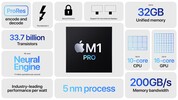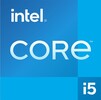Apple M1 Pro 8-Core vs Intel Core i5-13505H
Apple M1 Pro 8-Core
► remove from comparison
The Apple M1 Pro 8-Core is a System on a Chip (SoC) from Apple that is found in the late 2021 MacBook Pro 14 and 16-inch models. It offers 8 cores from the 10 available in the chip divided in six performance cores (P-cores with 600 - 3220 MHz) and four power-efficiency cores (E-cores with 600 - 2064 MHz). The cores are similar to the cores in the Apple M1.
The big cores (codename Firestorm) offer 192 KB instruction cache, 128 KB data cache, and 24 MB shared L2 cache (up from 12 MB in the M1). The four efficiency cores (codename Icestorm) are a lot smaller and offer only 128 KB instruction cache, 64 KB data cache, and 4 MB shared cache. Finally, the SoC includes 16 MB System Level Cache shared by the GPU. The efficiency cores (E cluster) clock with 600 - 2064 MHz, the performance cores (P cluster) with 600 - 3228 MHz.
The unified memory (16 or 32 GB LPDDR5-6400) next to the chip is connected by a 256 bit memory controller and can be used by the GPU and CPU.
The integrated graphics card in the M1 Pro offers 14 cores (of the 16 cores in the chip).
Furthermore, the SoC integrates a fast 16 core neural engine, a secure enclave (e.g., for encryption), a unified memory architecture, Thunderbolt 4 controller, an ISP, and media de- and encoders (including ProRes).
The M1 Pro is manufactured in 5 nm at TSMC and integrates 33.7 billion transistors. The peak power consumption of the chip was advertised around 30W for CPU intensive tasks.
Intel Core i5-13505H
► remove from comparison
The Intel Core i5-13505H is a mid-range mobile CPU for laptops based on the Raptor Lake-H series (Alder Lake or Raptor Lake architecture). It was announced in early 2023 and offers 4 of the 6 performance cores (P-cores, Golden Cove architecture) and all 8 efficient cores (E-cores, Gracemont architecture). The P-cores support Hyper-Threading leading to 16 supported threads when combined with the E-cores. The clock rate ranges from 2.6 to 4.7 GHz (single core boost, all core up to 4.6 GHz) on the performance cluster and 1.9 to 3.5 GHz on the efficient cluster. The performance of the E-cores should be similar to old Skylake cores (compare to the Core i7-6700HQ). All cores can use up to 18 MB L3 cache. Similar to the i5-13500H but without vPro support and the 13505H uses a different package and socket.
Performance
Thanks to the higher clock speeds of the improved Intel 7 process, the Core i5-13505H can surpass the old Core i5-12600H (e.g., + 200 MHz boost). The performance should be identical to the Core i5-13500H.
Features
The integrated memory controller supports various memory types up to DDR5-5200 (up from DDR5-4800 of the i5-12500H). The Thread Director (in hardware) can support the operating system to decide which thread to use on the performance or efficient cores for the best performance. For AI tasks, the CPU also integrates GNA 3.0 and DL Boost (via AVX2). Quick Sync in version 8 is the same as in the Rocket Lake CPUs and supports MPEG-2, AVC, VC-1 decode, JPEG, VP8 decode, VP9, HEVC, and AV1 decode in hardware. The CPU now supports PCIe 5.0 x8 for a GPU and two PCIe 4.0 x4 for SSDs.
The integrated graphics card is based on the Xe-architecture and offers 80 of the 96 EUs (Execution Units).
The CPU is rated at 45 W base power (95 W PL2) but most laptops will use a PL1 of around 60 Watt. The SoC is manufactured in a further improved 10nm process at Intel, which is known as Intel 7.
| Model | Apple M1 Pro 8-Core | Intel Core i5-13505H | ||||||||||||||||||||||||||||||||||||||||||||||||||||||||||||
| Series | Apple Apple M-Series | Intel Raptor Lake-H | ||||||||||||||||||||||||||||||||||||||||||||||||||||||||||||
| Series: Raptor Lake-H Raptor Lake-H |
|
| ||||||||||||||||||||||||||||||||||||||||||||||||||||||||||||
| Clock | 2060 - 3220 MHz | 1900 - 4700 MHz | ||||||||||||||||||||||||||||||||||||||||||||||||||||||||||||
| L1 Cache | 2.3 MB | 1.1 MB | ||||||||||||||||||||||||||||||||||||||||||||||||||||||||||||
| L2 Cache | 28 MB | 10 MB | ||||||||||||||||||||||||||||||||||||||||||||||||||||||||||||
| L3 Cache | 16 MB | 18 MB | ||||||||||||||||||||||||||||||||||||||||||||||||||||||||||||
| Cores / Threads | 8 / 8 | 12 / 16 | ||||||||||||||||||||||||||||||||||||||||||||||||||||||||||||
| Transistors | 33700 Million | |||||||||||||||||||||||||||||||||||||||||||||||||||||||||||||
| Technology | 5 nm | 10 nm | ||||||||||||||||||||||||||||||||||||||||||||||||||||||||||||
| Features | ARMv8 Instruction Set | Thread Director | ||||||||||||||||||||||||||||||||||||||||||||||||||||||||||||
| iGPU | Apple M1 Pro 14-Core GPU ( - 1296 MHz) | Intel Iris Xe Graphics G7 80EUs ( - 1450 MHz) | ||||||||||||||||||||||||||||||||||||||||||||||||||||||||||||
| Architecture | ARM | x86 | ||||||||||||||||||||||||||||||||||||||||||||||||||||||||||||
| Announced | ||||||||||||||||||||||||||||||||||||||||||||||||||||||||||||||
| Codename | Raptor Lake-H | |||||||||||||||||||||||||||||||||||||||||||||||||||||||||||||
| TDP | 45 Watt | |||||||||||||||||||||||||||||||||||||||||||||||||||||||||||||
| max. Temp. | 100 °C | |||||||||||||||||||||||||||||||||||||||||||||||||||||||||||||
| Socket | FCBGA1792 | |||||||||||||||||||||||||||||||||||||||||||||||||||||||||||||
| Manufacturer | ark.intel.com |


 Deutsch
Deutsch English
English Español
Español Français
Français Italiano
Italiano Nederlands
Nederlands Polski
Polski Português
Português Русский
Русский Türkçe
Türkçe Svenska
Svenska Chinese
Chinese Magyar
Magyar